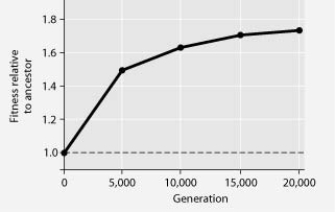In this eight-year experiment, 12 populations of E. coli, each begun from a single cell, were grown in low-glucose conditions for 20,000 generations. Each culture was introduced to fresh growth medium every 24 hours. Occasionally, samples were removed from the populations, and their fitness in low-glucose conditions was tested against that of members sampled from the ancestral (common ancestor) E. coli population. 
-If the experimental population of E. coli lacks an F factor or F plasmid, and if bacteriophages are excluded from the bacterial cultures, then beneficial mutations might be transmitted horizontally to other E. coli cells via ________.
A) sex pili
B) transduction
C) conjugation
D) transformation
Correct Answer:
Verified
Q22: In a hypothetical situation, the genes for
Q23: Use the following information and figure to
Q25: In this eight-year experiment, 12 populations of
Q27: A hypothetical bacterium swims among human intestinal
Q27: Which of the following is least associated
Q29: Nitrogenase, the enzyme that catalyses nitrogen fixation,
Q30: The following table depicts characteristics of five
Q31: Biologists sometimes divide living organisms into two
Q31: A hypothetical bacterium swims among human intestinal
Q32: Use of synthetic fertilisers often leads to
Unlock this Answer For Free Now!
View this answer and more for free by performing one of the following actions

Scan the QR code to install the App and get 2 free unlocks

Unlock quizzes for free by uploading documents